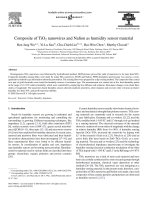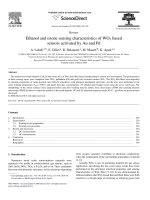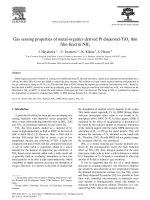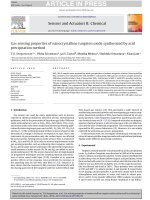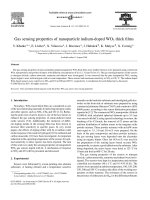Synthesis and gas sensing properties of tio2 nanowires
Bạn đang xem bản rút gọn của tài liệu. Xem và tải ngay bản đầy đủ của tài liệu tại đây (7.14 MB, 95 trang )
PHAM HONG TRANG
MINISTRY OF EDUCATION AND TRAINING
HANOI UNIVERSITY OF TECHNOLOGY AND SCIENCE
---------------------------------------
PHAM HONG TRANG
MATERIAL SCIENCE
SYNTHESIS AND GAS-SENSING PROPERTIES
OF TIO2 NANOWIRES
MASTER THESIS OF SCIENCE
MATERIAL SCIENCE
2009-2011
Hanoi – 2011
MINISTRY OF EDUCATION AND TRAINING
HANOI UNIVERSITY OF TECHNOLOGY AND SCIENCE
--------------------------------------PHAM HONG TRANG
SYNTHESIS AND GAS-SENSING PROPERTIES
OF TIO2 NANOWIRES
MASTER THESIS OF SCIENCE
MATERIAL SCIENCE
SUPERVISOR : ASS.PROF. NGUYEN VAN HIEU
Hanoi – 2011
1
ABSTRACT
INTERNATIONAL TRAINING INSTITUTE FOR MATERIALS SCIENCE
BATCH ITIMS 2009-2011
Title: Synthesis and gas-sensing properties of TiO2 nanowires.
Author: Pham Hong Trang
Batch: 2009-2011
Supervisor: Asso. Prof. Dr. Nguyen Van Hieu
Abstract: One-dimensional (1-D) TiO2 nanostructures have recently
attractedsignificant attention in gas-sensor applications because of their good
chemical stability, nontoxicity, and favorable electrical and optical properties.
Moreover, the fabrication and understanding of the growth mechanism of 1-D
TiO2 nanostructures can be a building block to be realized. In this study, we
report the gas sensing properties of the TiO2 nanowire prepared by reactive
sputtering technique and subsequently grown self-catalytically without the
use of any other catalyst metals on Si(100) at a moderate growth range of
temperature of (~650 to 850°C)using thermal oxidation process. The oxygen
source for the growing process is ethanol. The shape of the TiO2 nanowires are
wires which represents the tetragonal lattice structure of anatase and/or rutile
TiO2. The lengths, diameters of the nanowires are ~ (80-300)nm and ~ (1.22.5)nm respectively.
TiO2 thin films are extensively studied for application in gas sensor devices.
The films were first annealed at 5000C, 7000C, 9000C and exposed to different
concentration of H2 gas at 100, 250, 500ppm. Their gas sensing properties was
obtained by measuring their resistance and were strongly dependent on
synthesize technique, annealing temperature, wires size. This result was
compared with the sensing properties of TiO2nanopowder synthesized by
hydrothermal at the same range of H2 concentration.
2
TÓM TẮT LUẬN VĂN THẠC SĨ
VIỆN ĐÀO TẠO QUỐC TẾ VỀ KHOA HỌC VẬT LIỆU
Khóa ITIMS 2009-2011
Đềtài: Nghiên cứu chế tạo và tính chất nhạy khí của dây nano TiO2
Tácgiả: PhạmHồngTrang
Khóa: 2009-2011
Ngườihướngdẫn: PGS.TS. NguyễnVănHiếu
Nội dung tóm tắt: Trong những năm gần đây vật liệu cấu trúc nano TiO2 một chiều
đã thu hút sự chú ý đáng kể trong các ứng dụng cảm biến do tính chất bền hóa và
không độc hại. Hơn nữa, việc tìm hiểu chế tạo vật liệu cấu trúc nano TiO2 cũng
được được tiến hành. Trong nghiên cứu này, chúng tôi đưa ra phương pháp nghiên
cứu khả năng nhạy khí của vật liệu TiO2, đề tài được thực hiện với hai nhiệm vụ
chính :
- Nghiên cứu quy trình chế tạo dây TiO2
- Khảo sát tính chất nhạy khí của dây nano TiO2
Đế vật liệu được chuẩn bị bằng kỹ thuật phún xạ và sau đó tiến hành quá trình tổng
hợp tự xúc tác không sử dụng kim loại làm chất xúc tác trên Si (100) trong khoảng
nhiệt độ (~650-8500C) bằng cách sử dụng quá trình ôxy hóa nhiệt. Nguồn ôxy cho
quá trình phát triển là ethanol. Các dây nano TiO2 có cấu trúc mạng tứ diện anatase
và / hoặc TiO2 Rutile. Độ dài, đường kính của dây nano TiO2 lần lượt là (8-30) nm
và ~ (1,2-2,5) nm.
Màng mỏng TiO2 được nghiên cứu rộng rãi cho các ứng dụng trong các thiết bị cảm
biến khí. Các sensor sau khi được chế tạo được ủ ở 5000C, 7000C, 9000C và được
kiểm tra tính nhạy khí với các nồng độ của H2 là 100, 250, 500 ppm. Các đặc tính
nhậy khí thu được bằng cách đo điện trở sensor và phụ thuộc rất nhiều về kỹ thuật
tổng hợp, nhiệt độ ủ, kích thước dây.
Kết quả này so sánh với các thuộc tính cảm ứng của bột TiO2 chế tạo bằng phương
pháp thủy nhiệt tại cùng khoảng nồng độ H2 như trên. Qua so sánh nhận thấy rằng
sensor trên nền vật liệu TiO2 chế tạo bằng phương pháp vật lý có độ nhạy không
thua kém so với sensor chế tạo trên nền vật liệu bột TiO2 bằng phương pháp hóa
học.
3
ASSURANCE
I hereby declare that the thesis named “Synthesis and Characterization of One Dimensional TiO2 Nanowires” is the individual study that actually based on
theoretical studies and experimental work at Gas Sensor group under the supervise
of Ass.Prof. Nguyen Van Hieu and the results and data presented in this thesis are
true, and have never been published in other previous works.
I would confirm that this assurance istrue.
Hanoi, October 2011
LỜI CAM ĐOAN
Tôi xin cam đoan bản luận văn “ Nghiên cứu chế tạo và tính chất nhạy khí của dây
nano TiO2” là công trình nghiên cứu thực sự của cá nhân tôi trên cơ sở nghiên cứu
lý thuyết và tiến hành thực nghiệm tại nhóm Cảm biến khí dưới sự hướng dẫn của
PGS. TS. Nguyễn Văn Hiếu. Các số liệu và kết quả được trình bày trong luận văn là
trung thực và chưa được công bố trong các công trình khác trước đây.
Tôi xin khảng định lời cam đoan trên là đúng sự thật.
Hà Nội, tháng 10 năm 2011
Tácgiả
Phạm Hồng Trang
4
Acknowledgments
Firstly, I am deeply grateful to my advisor Professor Nguyen Van Hieu for
his direct guidance and advising me during my Master course. He has believed
and encouraged me by creating all the best conditions and opportunities possible
for my research.
I would like to express my gratitude to all the members of Gas Sensor group
for their availability and willingness to share their knowledge and materials,
especially their skill of doing experiments and using devices. It would be difficult
for me to reach this final without their helps.
I also thank to Hanoi Institute of Hygiene Epidemiology - Center for Electron
Microscopy,....for their help in SEM, X-ray measurement.
I would like to thank the committee members for their valuable comments and
suggestions on my thesis.
I thank all the members in the laboratory and staffs from ITIMS for their
help in my life and my work. Whenever I needed their support, they were pleased
to help me.
Finally but not least, I would like to thank family for their endless support and
encouragement during all studies starting from day one.
Hanoi, October 2011
Author
Pham Hong Trang
5
Contents
ABSTRACT ................................................................................................................2
ASSURANCE ............................................................................................................3
Acknowledgments .....................................................................................................4
List of tables ...............................................................................................................5
List of Figures ............................................................................................................6
Preface ......................................................................................................................13
Chapter I ................................................................... Error! Bookmark not defined.
Introduction to TiO2 – based material ....................... Error! Bookmark not defined.
1.1 Preview on TiO2 nano structure ........................ Error! Bookmark not defined.
1.1.1 Crystal structure and chemical bonding ...... Error! Bookmark not defined.
1.1.2 Synthesis methods for 1-D TiO2nanostructures........................................20
1.2 Synthesis mechanism for 1-D TiO2 nanostructures... Error! Bookmark not
defined.
1.2.1 Vapor – Liquid – Solid (VLS) Mechanism ............ Error! Bookmark not
defined.
1.2.2 Vapor –Solid (VS) Mechanism ................ Error! Bookmark not defined.
1.2.3 Solution - Liquid –Solid (SLS) Mechanism........... Error! Bookmark not
defined.
1.3 Characterization techniques for 1-D TiO2 nanostructures .. Error! Bookmark
not defined.
1.3.1 Scanning electron microscopy .................. Error! Bookmark not defined.
1.3.2 Transmission electron microscopy............ Error! Bookmark not defined.
1.3.3 Raman spectroscopy .................................................................................30
1.3.4 X-Ray photoelectron spectroscopy (XPS) ...............................................30
1.4 Gas sensing application ...................................................................................31
1.4.1 Introduction to gas sensor .........................................................................31
1.4.2. The characteristics of gas sensors ............ Error! Bookmark not defined.
1.4.3 Responsibility and Influencing Factors .... Error! Bookmark not defined.
Chapter II .................................................................. Error! Bookmark not defined.
6
Experimental Techniques ........................................ Error! Bookmark not defined.
2.1 Synthesis of 1-D TiO2 nanostructures by thermal oxidationError! Bookmark
not defined.
2.1.1 Specimens and tools preparation .............. Error! Bookmark not defined.
2.1.2 Synthesis of 1-D TiO2 nanostructures of TiO2 thin film .............. Error!
Bookmark not defined.
2.2 Synthesis of 1-D TiO2 nanostructures by hydrothermal ..... Error! Bookmark
not defined.
2.2.1 Source materials and preparation methods............. Error! Bookmark not
defined.
2.2.2 Synthesis of 1-D TiO2 nanostructures of TiO2 nano powder ........... Error!
Bookmark not defined.
2.3 Sensor fabrication ............................................................................................50
Chapter III ................................................................ Error! Bookmark not defined.
Results and Discussion .............................................. Error! Bookmark not defined.
3.1 Surface morphological analysisof 1-D TiO2 nanostructure . Error! Bookmark
not defined.
3.1.1 Analysis of TiO2 sputtering layer.............. Error! Bookmark not defined.
3.1.2 Morphological analysis of TiO2 nanowire using thermal oxidation. Error!
Bookmark not defined.
3.1.3 Morphological analysis of TiO2 nanopowder using hydro thermal…….73
3.2 X-ray diffraction analysis ................................ Error! Bookmark not defined.
3.2.1 X-ray diffraction analysis of TiO2 nanowires ......... Error! Bookmark not
defined.
3.2.2 X-ray diffraction analysis of TiO2 nanopowder...... Error! Bookmark not
defined.
3.3 Gas sensing properties analysis.................... Error! Bookmark not defined.
3.3.1 Gas sensing properties analysis of TiO2 nanowires Error! Bookmark not
defined.
3.3.2 Gas sensing properties analysis of TiO2 nanopowder...............................82
3.3.3 Gas sensing property comparison ............. Error! Bookmark not defined.
Conclusions .............................................................. Error! Bookmark not defined.
7
References ................................................................ Error! Bookmark not defined.
8
List of Tables
Page
Table 1.1.
TiO2 phases and their lattice constants
20
Table 2.1.
The experimental modes and the numbers of experiments taken
in each mode
47
Table 2.2.
The experimental modes which have stable repetition
48
Table 3.1.
H2 (0.5%) gas concentrations
52
9
List of Figures
Page
Figure 1.1
High-purity (99.999%) titanium with visible crystal structure
15
Figure 1.2
Electron configuration of Titanium
16
Figure 1.3
Titanium dioxide
17
Figure 1.4
The crystal structure of (a) anatase and (b) rutile
18
Figure 1.5
Unit cell of polymorphs of TiO2: (a) anatase and (b) rutile
19
The stage of alloying, nucleation and growth of nanowire
Figure 1.6
synthesis arcording to the VLS growth mechanism.
24
Pseudobinary phase diagram of semiconductor – gold system.
Schematic describing the formation of nanowires by solution
Figure 1.7
methods: (a) SLS growth mechanism, (b) growth-oriented
self-assembly, (c) the growing process with the aid of
27
surface-active substances.
Figure 1.8
Schematic drawing of the Scanning electron microscopy
28
Figure 1.9
Schematic drawing of Transmission electron microscopy
29
Figure 1.10
Schematic drawing of Raman
30
Figure 1.11
Schematic drawing of -Ray photoelectron spectroscopy
31
Figure 1.12
The change of gas sensor resistance when putting test gas
35
Figure 1.13
Gas sensing mechanism of Sn2O3-doped SnO2 in the
atmosphere of (a) C2H2 and (b) C2H2 and humidity.
39
Figure 2.1
Schematic of sputtering system
42
Figure 2.2
Si substrate after sputtering
44
Figure 2.3
Specimen container (boat) being dried on drying stove
45
Figure 2.4
Schematic drawing of the thermal CVD system for the
synthesis of TiO2 nanowires
46
Figure 2.5
Thermal CVD horizontal furnace GERO GmBH
47
Figure 2.6
Heating diagram
49
Figure 2.7
Platinum electrodes on Si/SiO2 substrate
50
10
Figure 2.8
(a), (b) Comb electrodes before and (c) after attaching TiO2
nanowires
51
Figure 2.9
TiO2nano powder synthesized by hydrothermal method
51
Figure2.10
Diagram of gas sensing device
53
Figure 3.1
Figure 3.2
Figure 3.3
Figure 3.4
Figure 3.5
Figure 3.6
Figure 3.7
Figure 3.8
Figure 3.9
Figure 3.10
Figure 3.11
Figure 3.12
Figure 3.13
Scanning electron micrograph (SEM) of a cross-section of Si
substrate with Ti sputtering layer
Scanning electron micrograph (SEM) of TiO2 nanowires at
7000C and ethanol concentration of 20sccm
Scanning electron micrograph (SEM) of TiO2 nanowires at
7000C and ethanol concentration of 30sccm
Scanning electron micrograph (SEM) of TiO2 nanowires at
7500C and ethanol concentration of 10sccm
Scanning electron micrograph (SEM) of TiO2 nanowires at
7500C and ethanol concentration of 15sccm
Scanning electron micrograph (SEM) of TiO2 nanowires at
7500C and ethanol concentration of 20sccm
Scanning electron micrograph (SEM) of TiO2 nanowires at
7500C and ethanol concentration of 25sccm
Scanning electron micrograph (SEM) of TiO2 nanowires at
7500C and ethanol concentration of 30sccm
Scanning electron micrograph (SEM) of TiO2 nanowires at
8500C and ethanol concentration of 20sccm
Scanning electron micrograph (SEM) of TiO2 nanowires at
8500C and ethanol concentration of 50sccm
Scanning electron micrograph (SEM) of TiO2 nanowires at
8500C and ethanol concentration of 80sccm
Scanning electron micrograph (SEM) of TiO2 nanowires at
55
56
57
57
58
59
60
61
62
63
64
8500C and ethanol concentration of 100sccm
65
Morphology of specimens at the same concentration of
67
11
20sccm C2H5OH at (a) 7000C, (b) 7500C and (c) 8500Cmagnification of 20k
Morphology of specimens at the same concentration of
Figure 3.14
20sccm C2H5OH at (a) 7000C, (b) 7500C and (c) 8500C-
68
magnification of 40k
Morphology of specimens at the same concentration of
Figure 3.15
20sccm C2H5OH at (a) 7000C, (b) 7500C and (c) 8500C-
69
magnification of 80k
Figure 3.16
Figure 3.17
Figure 3.18
Figure 3.19
Figure3.20
Figure 3.21
Figure 3.22
Morphology of specimens heating at 7000C with ethanol
concentration varied from 20-30 sccm.
70
Morphology of specimens heating at 7500C with ethanol
concentration varied from 10-30 sccm
71
Morphology of specimens heating at 8500C with ethanol
concentration varied from 20-100 sccm
Scanning electron micrograph (SEM) of TiO2nano powder
X-ray diffraction patterns of TiO2 nanowire synthesized at
7500C/15sccm
X-ray diffraction patterns of TiO2nanopowder without
annealing and annealing at 6500C/2h
Gas sensing characteristic of TiO2 nanowires with annealing
temp: 500°C /gas concentration : (a)100- (b)250- (c)500ppm
72
74
75
76
77
Gas sensing characteristic comparison of TiO2 nanowires
Figure 3.23
with annealing temp: 500°C /gas concentration : 100- 250-
77
500ppm
Figure 3.24
Gas sensing characteristic of TiO2 nanowires with annealing
temp: 700°C /gas concentration : (a)100- (b)250-(c)500ppm
79
Gas sensing characteristic comparison of TiO2 nanowires
Figure 3.25
with annealing temp: 700°C /gas concentration : 100- 250500ppm
12
79
Figure 3.26
Gas sensing characteristic of TiO2 nanowires with annealing
temp: 900°C /gas concentration : (a)100- (b)250-(c)500ppm
80
Gas sensing characteristic comparison of TiO2 nanowires
Figure 3.27
with annealing temp: 900°C /gas concentration : 100- 250-
81
500ppm
Gas sensing characteristic comparison of TiO2 nanowires gas
Figure 3.28
sensor with annealing temperature varied from 5000C, 7000C,
82
0
900 C
Figure 3.29
Gas sensing characteristic of TiO2 nanowires with annealing
temp: 700°C /gas concentration : (a)100- (b)250-(c)500ppm
83
Gas sensing characteristic comparison of TiO2nanopowder
Figure 3.30
with annealing temp: 700°C /gas concentration : 100- 250-
83
500ppm
Figure 3.31
Gas sensing characteristic comparison of TiO2 nanowire
13
84
Preface
TiO2 nanowire
materials
fabricated
by
the
physical
methods
is
complicatedbecause of their high melting points and the absence of catalyst
metals which enhance vapor-solid growth at a moderate growth temperaturebut this
methods can achieve uniformity in quality and size of wires, but has the
advantage of easy to make sensor series with large numbers. In contrast,
TiO2nanopowderwhich is made by chemical methods has the advantage of being
easy to synthesized in large amount, however, it is difficult to fabricate the sensor
in large number. This thesis focus on synthesize TiO2nanowires by thermal
oxidation method and study the gas sensing properties of this material, besides,
this also carry synthetic on TiO2 powder by hydrothermal method with the
purpose of comparing advantages and disadvantages of the thermal oxidation
method with hydrothermal methods to draw conclusions about the gas sensing
characteristics of TiO2 naowires.
In this thesis, we focus on the synthesis and characterization of 1-D TiO2
nanostructures. A catalyst-free method is employed using Ti thin film on Si
substrate via sputtering process as seeds for TiO2 nanowires grow oxygen
source such as ethanol is introduced to grow TiO2 nanowires. The electrical and
structural properties of the 1-D TiO2 nanostructures are studied using SEM, Xray diffraction and electron microscopy, etc.Moreover, the gas responsibility
properties of 1-D TiO2 nanostructures are also studied in details. A highly
responsibility to H2 gas sensor was prepared by the thermal oxidation of a Ti thin
film sputtered on Si plate in C2H5OH at 600-850oC. The thermally oxidized
specimens were annealed at different temperatures before the sensing test to
obtained the sensitivity at temperatures as high as 7500C.
To receive further characteristics of gas sensing of TiO2 nanomaterial, a
hydrothermal route for preparing TiO2nano powder is proposed. The standard
14
procedure for preparation is to suspense TiO2 powder in concentrated alkaline
solution.
TiO2 nano scale material received from this two procedures have been
characterized by the modern physicochemical such as X-ray diffraction (XRD),
scanning electron microscopy (SEM) and gas sensing test. The films and powder
were exposed to different concentrations of H2 gas up to 500ppm. Their sensitivity
to gas at high temperature of 7500C was obtained by measuring their resistance.
The thesis is divided into three chapters:
Chapter 1: Introduction and some preview on TiO2 and some synthesis methods
and applications of 1-D TiO2 nanostructures.
Chapter 2: Introduce the experimental techniques used in this work for growth and
characterization of specimens.
Chapter 3: The results of synthesis and characterization of TiO2 singlecrystalline nanostructures by oxidation of Ti films and hydrothermal are
introduced and discussed. Finally, remarkable conclusions are also given.
15
Chapter I
Introduction to TiO2 – based material
1.1 Preview on TiO2nano structure
1.1.1 Crystal structure and chemical bonding
Ti is a chemical element with the symbol Ti and atomic number 22. It has a low
density and is a strong, lustrous, corrosion-resistant transition metal with a silver
color. A metallicelement, titanium is recognized for its high strength-to-weight ratio
and is a strong metal with low density that is quite ductile. The relatively high melting
point of more than 1,650 °C makes it useful as a refractory metal. It is paramagnetic
and has fairly low electrical and thermal conductivity. Titanium have ultimate tensile
strength of about 434 MPa. [1]
Figure 1.1 High-purity (99.999%) titanium with visible crystal structure
The metal is a dimorphic allotrope whose hexagonal alpha form changes into a
body-centered cubic (lattice) β form at 882 °C (1,620 °F). The specific heat of the
alpha form increases dramatically as it is heated to this transition temperature but then
falls and remains fairly constant for the β form regardless of temperature. This phase
is usually hexagonal (ideal) or trigonal (distorted) and can be viewed as being due to
a soft longitudinal acoustic phonon of the β phase causing collapse of (111) planes of
atoms. The most noted chemical property of titanium is its excellent resistance to
corrosion; it is almost as resistant as platinum, capable of withstanding attack by
15
dilute sulfuric acid and hydrochloric acid as well as chlorine gas, chloride solutions,
and most organic acids. However, it is soluble in concentrated acids. However, it is
slow to react with water and air, because it forms a passive and protective oxide
coating that protects it from further reaction.
Figure 1.2 Electron configuration of Titanium
TiO2 materials is a wide band gap semiconductor of (3.2-3.8)eV, having the
outstanding properties such as a high refractive index as well as an excellent
transmittance in the visible and near-infrared range, a high dielectric constant with
physical, chemical stability, and non-toxicity. TiO2 forms in the three different
structures: rutile, anatase and brookite. Rutile is the stable phase at high
temperatures, but anatase and brookite are common in fine grained (nanoscale)
natural and synthetic samples. The band gap of anatase and rutile is 3.2 and 3.0 eV,
respectively. Via thermal annealing, the following transformations are all seen:
anatase to brookiteto rutile, brookite to anatase to rutile, anatase to rutile, and
brookite to rutile. These transformation sequences imply very closely balanced
energetics as a function of particle size. The minerals rutile and brookite as well as
anatase all have the same chemistry, TiO2, but they have different structures. At
higher temperatures, about 915 0C, anatase will automatically revert to the rutile
structure. Rutile is the more common and the more well-known mineral of the
three, while anatase is the rarest. Anatase shares many of the same or nearly the
same properties as rutile such as luster, hardness and density. However due to
structural differences anatase and rutile differ slightly in crystal habit and more
distinctly in cleavage.
16
Figure 1.3Titanium dioxide
Anatase and rutile have the same symmetry, tetragonal 4/m 2/m 2/m, despite
having different structures. In Rutile, the structure is based on octahedrons of
titanium oxide which share two edges of the octahedron with other octahedrons
and form chains. It is the chains themselves which are arranged into a four-fold
symmetry. In anatase, the octahedrons share four edges hence the four fold axis.
Crystals of anatase are very distinctive and are not easily confused with any
other mineral. They form the eight faced tetragonal dipyramids that come to sharp
elongated points. The elongation is pronounced enough to distinguish this crystal
form from octahedral crystals, but there is a similarity. In fact anatase is wrongly
called "octahedrite" in spite of the difference in forms.
The surface enthalpies of the three polymorphs are sufficiently different that
crossover in thermodynamic stability can occur under conditions that preclude
coarsening, with anatase and/or brookite stable at small particle size [1,2]. The
crystal structures properties of TiO2 are summarized in the table 1.1 [3]. The
crystal diagrams and unit cell of two most stable structures of TiO2, anatase and
rutile phases are shown in Figure 1.4 [4] and 1.5, respectively.
Since its commercial production in the early twentieth century, titanium
dioxide (TiO2) has been widely used as a pigment [5] and in sunscreens [6], paints
[7], ointments, toothpaste [8], etc. Since Fujishima and Honda discovered the
phenomenon of photocatalytic splitting of water on a TiO2 electrode under
17
ultraviolet (UV) light in 1972 [9], TiO2 material has been extensive researched for
many promising applications such as photovoltaic, photocatalysis, photo/electrochromics and sensors [10-13]. These applications can be roughly divided
into “energy” and “environmental” categories, many of which depend not only
onthe properties of the TiO2 material itself but also on the modifications of the
TiO2 material host (e.g., with inorganic and organic dyes) and on the interactions
of TiO2 materials with the environment [14].
Recently, the challenges for the development of future technologies of
electronics is the realization of devices that control not only the electron charge, as
in present electronics, but also its spin, setting the basis for future spintronics.
Spintronics represents the concept of the synergetic and multifunctional use of
charge and spin dynamics of electrons, aiming to go beyond the traditional
dichotomy of semiconductor electronics and magnetic storage technology.
Figure 1.4 The crystal structure of (a) anatase, (b) rutile and (c) brookite.
18
In the emerging field of nanotechnology, a goal is to make nanostructures
with special properties with respect to those of bulk or single-particle species. An
exponential growth of research activities has been seen in the past decades [21-25].
The unique physical and chemical properties exhibit when the size of the material
becomes smaller and smaller, and down to the nanometer scale. Among the
unique properties of nanomaterials, the movement of electrons and holes in
semiconductor nanomaterials is primarily governed by the well-known quantum
confinement, and the transport properties related to phonons and photons are
largely affected by the size and geometry of the materials [21-24]. The specific
surface area and surface-to-volume ratio increase dramatically as the size of a
material decreases [21,26].
Figure 1.5 Unit cell of polymorphs of TiO2: (a) anatase and (b) rutile.
As the most promising photocatalyst [12-14], TiO2materials are expected to
play an important role in helping solve many serious environmental and pollution
challenges. TiO2also bears tremendous hope in helping ease the energy crisis
through effective utilization of solar energy based on photovoltaic and watersplitting devices [10,27,28].
19
However, to further promote TiO2-based development efforts to solve the
environmental and energy challenges would require the fabrication of onedimensional (1-D) TiO2 nanostructures such as nanobelts and nanowires.
Furthermore, the seamless integration of future spintronic devices into
nanodevices would also require the fabrication of 1-D DMS nanostructures in
well-defined architectures.
Table 1.1 TiO2 phases and their lattice constants.
Crystal structure
Anatase
Rutile
Brookite
Form. weight
79.89
79.89
79.89
Z
4
2
8
Crystal system
Tetragonal
Tetragonal
Orthorhombi
Point group
4/mmm
4/mmm
c
Mmm
Space group
I41amd
P42/mnm
Pbca
3.7842
4.5845
9.184
Unit cell
a (Å)
b (Å)
5.447
c (Å)
9.5146
2.9533
5.145
Vol.
136.25
62.07
257.38
Molar vol.
20.156
18.693
19.377
Density
3.895
4.2793
4.123
1.1.2 Synthesis methods for 1-D TiO2nanostructures
Hydrothermal method
20
Hydrothermal synthesis is normally used a steel pressure vessel which called
autoclave with or without teflon liners under controlled temperature and/or
pressure with the reaction in aqueous solutions. The temperature can be elevated
above the boiling point of water, reaching the pressure of vapor saturation. The
temperature and the amount of solution added to the autoclave largely determine
the internal pressure produced. It is a method that is widely used for the
production of small particles in the ceramics industry. Many groups have used the
hydrothermal
method
to
prepare
1-D
TiO2nanostructures
such
as
nanorods[29,30], nanowires [31,32], and nanotubes [33-36].
Electrodeposition
Electrodeposition is commonly employed to produce a coating, usually
metallic, on a surface by the action of reduction at the cathode. The substrate to be
coated is used as cathode and immersed into a solution which contains a salt of the
metal to be deposited. The metallic ions are attracted to the cathode and reduced
to metallic form. With the use of the template of an AAM, TiO2 nanowires can be
obtained by electrodeposition [37-38].
Vapor deposition refers to any process in which materials in a vapor state are
condensed to form a solid-phase material. Recently, they have been widely
explored to fabricate various nanomaterials. Vapor deposition processes usually
take place within a vacuum chamber. If no chemical reaction occurs, this process
is called physical vapor deposition (PVD); otherwise, it is called chemical vapor
deposition (CVD). In CVD processes, thermal energy heats the gases in the
coating chamber and drives the deposition reaction. The CVD method has been
used to fabrication 1-D TiO2 nanostructures such as nanorods, nanowalls,
nanosheets and nanobelts [39-41].
Physical vapor deposition
In physical vapor deposition (PVD), materials are first evaporated and then
condensed to form a solid material. The primary PVD methods include thermal
deposition, ion plating, ion implantation, sputtering, laser vaporization, and laser
21
surface alloying. TiO2 nanowire arrays have been fabricated by a simple PVD
method or thermal deposition [42-44].
Direct oxidation method
1-D TiO2 nanostructures can be obtained by oxidation of titanium metal
using oxidants or under anodization. Crystalline TiO2nanorods have been
obtained by direct oxidation of a titanium metal plate with hydrogen peroxide
[45-46]. At high temperature, 1-D TiO2 nanostructures can be obtained by
oxidizing a Ti plate with acetone, methanol, ethanol, etc as a good oxygen source
[47-48]. Highly dense and well-aligned TiO2nanorod arrays were formed when
acetone was used as the oxygen source, and only crystal grain films or grains
with random nanofibers growing from the edges were obtained with pure oxygen
or argon mixed with oxygen. The competition of the oxygen and titanium
diffusion involved in the titanium oxidation process largely controlled the
morphology of the TiO2. With pure oxygen, the oxidation occurred at the Ti
metal and the TiO2 interface, since oxygen diffusion predominated because of
the high oxygen concentration. When acetone was used as the oxygen source, Ti
diffused to the oxide surface and reacted with the adsorbed acetone species. As
extensively studied, TiO2 nanotubes can be obtained by anodic oxidation of
titanium foil [49-50].
1.2 Synthesis mechanism for 1-D TiO2 nanostructures
1.2.1 Vapor – Liquid – Solid (VLS) Mechanism
Nanowires are commonly grown using vapor, solution or electrodeposition
methods.High temperature growth from the vapor phase is often preferred due to the
high crystal quality that can be obtained and the ability to grow large quantities of
wires at once. A key factor in most vapor- and solution-based methods is the
presence of smallmetal droplets during synthesis. Analysis of the growth of silicon
whiskersfrom the vapor phase using gold catalyst particles lead to the postulation of
the Vapor-Liquid-Solid (VLS) mechanism of growth.The VLS mechanism consists
22
of three stages which are illustrated in figure 1.6 A. First, a metal particle absorbs
semiconductor material and forms an alloy. In this step the volume of the particle
increases and the particle often transitions from a solid to a liquid state. Second, the
alloy particle absorbs more semiconductor material until it is saturated. The
saturated alloy droplet becomes in equilibrium with the solid phase of the
semiconductor and nucleation occurs (i.e. solute/solid phase transition). During the
final phase, as steady state is formed in which a semiconductor crystal grows at the
solid/liquid interface. The precipitated semiconductor material grows as a wire
because it is energetically more favorable than extension of the solid-liquid
interface. That semiconductor material is precipitated at the existing solid/liquid
interface as opposed to the formation of a new interface In the VLS mechanism, the
wire diameter is determined by the diameter of the alloy particle which is in turn
determined by the low temperature size of the metal particle and the temperature.
The wire length is determined by the growth rate and time.
23
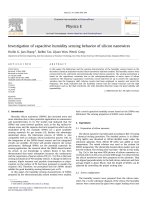
![Structures and electronic properties of si nanowires grown along the [1 1 0] direction role of surface reconstruction](https://media.store123doc.com/images/document/14/rc/td/medium_tdu1394959072.jpg)

